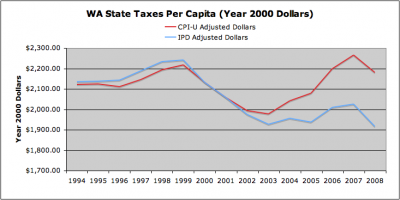Following up on yesterday’s post in which I explain for reporters why population-plus-inflation does not result in a stable revenue stream necessary to maintain government services at constant levels, I thought I’d quickly raise one more question in the minds of the press before they attempt to cover I-1033 in an objective and even-handed manner: what problem, exactly, is I-1033 intended to solve?
It can’t be because Washington is a high tax state. Even by the measurement of the conservative Tax Foundation, the organization whose stats Tim Eyman has long cherry-picked to support his tax cutting initiatives, Washington now ranks 35th in terms of state and local tax burden, and has climbed to 9th on the list of states with the best business tax climate.
And it certainly can’t be because government spending is out of control. Again, according to the Tax Foundation, Washington’s state and local tax burden (the percentage of one’s income one pays in state and local taxes, on average) has steadily dropped over the past 15 years from 10.4% in 1995 to 8.9% in 2008. And as I have pointed out on numerous occasions, per capita state tax revenues, adjusted for inflation, have also sunk to a 15-year low… and that’s before most of the impact of the Great Recession kicked in.
So what exactly is Timmy trying to fix? Certainly not out-of-control government spending. And certainly not potholes.

